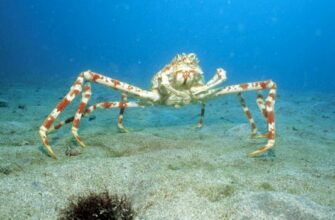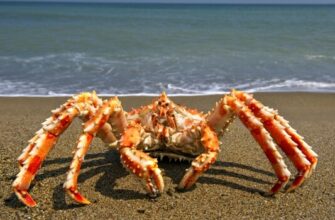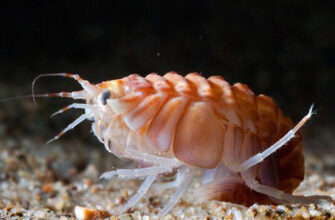The palm thief is a very large cancer, more like a crab. In particular, his claws are impressive – if you bite them, then a person will not be in trouble. But these crayfish do not show aggression towards people, at least the first ones, but they can catch small animals, including even birds. They go hunting at dusk because they don't like the sun.
Origin of the species and description
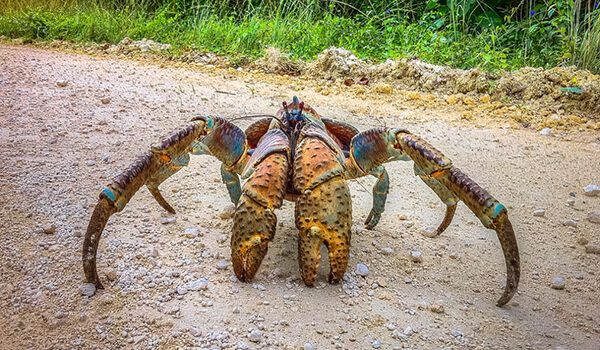
Photo: Palm thief
Palm thief belongs to ten-legged crayfish. The scientific description was first made by C. Linnaeus in 1767, when he received his species name latro. But its original generic name Cancer was changed in 1816 by W. Leach. This is how the Birgus latro, which has survived to this day, appeared.
The first arthropods appeared about 540 million years ago, when the Cambrian was just beginning. Unlike many other cases when, after the appearance, a group of living organisms evolve slowly for a long time, and the diversity of species remains low, they became an example of “explosive evolution”.
Video: Palm Thief
This is the name given to the sharp development of a class, in which it generates a very large number of forms and species in a short (by evolutionary standards) period of time. Arthropods immediately mastered the sea, and fresh water, and land, and crustaceans appeared, which are a subtype of arthropods.
Compared to trilobites, arthropods have undergone a number of changes:
- they acquired a second pair of antennae, which also became an organ of touch;
- the second limbs became shorter and stronger, they turned into mandibles intended for grinding food;
- the third and fourth pair of limbs, although they retained the motor function, but also became adapted for grasping food;
- the gills on the head limbs were lost;
- the functions of the head and chest were separated;
- over time, the chest and abdomen stood out in the body.
All these changes were aimed at ensuring that the animal could move more actively in order to search for food, better catch and process it. From the most ancient crustaceans of the Cambrian period, many fossil remains remained, at the same time higher crayfish appeared, which include the palm thief.
For some crayfish of that time, the modern type of nutrition is already characteristic, and in general the structure of their body cannot be called less perfect than that of modern species. Although the species that lived on the planet then died out, modern ones are similar in structure to them.
This makes it difficult to restore the picture of the evolution of crustaceans: it is impossible to trace how they gradually became more complex with time. Therefore, it has not been reliably established when palm thieves appeared, but their evolutionary branch can be traced back hundreds of millions of years, all the way to the Cambrian.
Interesting fact: Among crustaceans, there are even those that can be considered alive fossils – Triops cancriformis lived on our planet for 205-210 million years.
Appearance and features
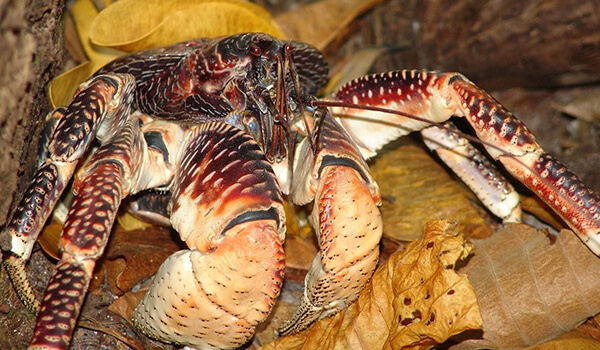
Photo: What the palm thief looks like
The palm thief is a very large crayfish: it grows up to 40 cm and weighs up to 3.5-4 kg. Five pairs of legs grow on its cephalothorax. The front one, which has powerful claws, is larger than the others: it is noteworthy that they differ in size – the left one is much larger.
The next two pairs of legs are also powerful, thanks to which this crayfish can climb trees. The fourth pair is inferior in size to the previous ones, and the fifth is the smallest. Thanks to this, young crayfish can squeeze into other people's shells that protect them from behind.
It is precisely because the last two pairs of legs are poorly developed that it is easiest to establish that the palm thief should be classified as a hermit crabs, but not at all not to crabs, for which this is uncharacteristic. But the front pair is well developed: with the help of claws on it, the palm thief is able to drag objects ten times heavier than himself, and they can also become a dangerous weapon.
Since this cancer has a well-developed exoskeleton and full-fledged lungs, it lives on land. It is curious that its lungs consist of the same tissues as the gills, but they absorb oxygen from the air. At the same time, he also has gills, but they are underdeveloped and do not allow him to live in the sea. Although he begins his life there, but after he grows up, he loses the ability to swim.
The palm thief makes an impression with his appearance: he is very large, especially the claws stand out, because of which this cancer looks menacing and looks very much like a crab. But he does not pose a danger to a person, only if he does not decide to attack: then the palm thief can really inflict a wound with these pincers.
Where does the palm thief live?
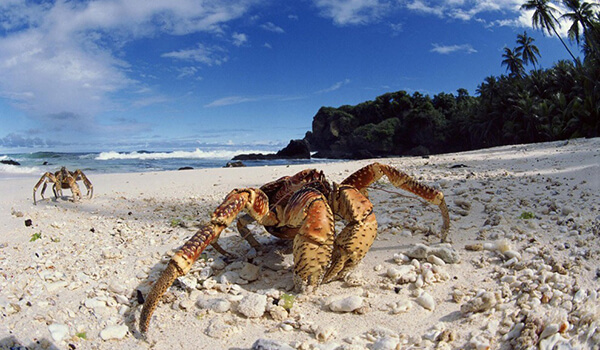
Photo: Palm Thief Crab
Their range is quite wide, but at the same time they live mostly on islands of modest size . Therefore, although they are scattered from the coast of Africa in the west and almost to South America in the east, the land area on which they can live is not so large.
The main islands on which you can meet the palm thief :
- Zanzibar;
- East Java;
- Sulawesi;
- Bali;
- Timor ;
- Philippines;
- Hainan;
- Western Oceania.
Little Christmas Island is known as the place where these crayfish are most densely populated: they can be found there almost at every step. As can be seen from the list as a whole, they prefer warm tropical islands, and even in the subtropics they are almost never found.
Although they also settle on large islands, like Hainan or Sulawesi, they prefer small ones located next to large ones. For example, in New Guinea, if they can be found, it is very rare, on the small islands lying to the north of it – very often. It's the same with Madagascar.
They generally don't like to live near people, and the more developed the island becomes, the fewer palm thieves remain there. Small, preferably generally uninhabited islands suit them best. They make their burrows near the coastline, in coral rock or rock crevices.
Interesting fact: Often these crayfish are called coconut crabs. This name arose due to the fact that it was previously believed that they climbed palm trees in order to cut the coconut and feast on it. But this is not true: they can only look for already fallen coconuts.
What the palm thief eats
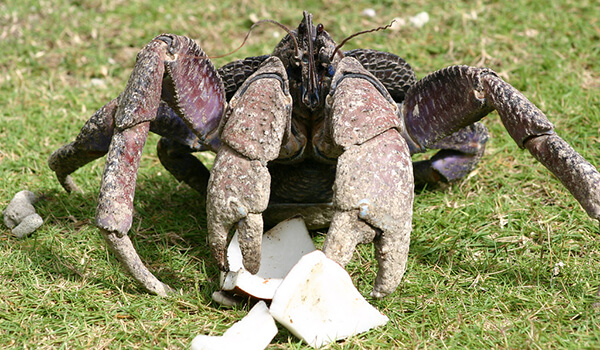
Photo: Palm thief in nature
His the menu is very varied and includes both plants and living organisms, and carrion.
Most often he eats:
- the contents of coconuts;
- pandan fruits;
- crustaceans;
- reptiles;
- rodents and other small animals.
He does not care what he eats from living creatures – as long as it is not poisonous. He catches any small prey that is not fast enough to get away from him, and not careful enough not to catch his eye. Although the main sense that helps him when hunting is the sense of smell.
He is able to smell prey at a great distance, up to several kilometers for things that are especially attractive and odorous to him – namely, ripe fruits and meat. When the inhabitants of tropical islands told scientists about how good the sense of smell these crayfish had, they believed that they were exaggerating, but experiments confirmed this information: baits attracted the attention of palm thieves from a distance of kilometers, and they unmistakably aimed at them!
The owners of such a phenomenal sense of smell are definitely not threatened with death from starvation, especially since the coconut thief is not picky, he can easily eat not only ordinary carrion, but even detritus, that is, long-decomposed remains and various secretions of living organisms. But still prefers to eat coconuts. Finds the fallen and, if they are at least partially split, tries to break them with the help of claws, which sometimes takes a long time. It is not capable of breaking the shell of a whole coconut with claws – it was previously believed that they could, but the information was not confirmed.
Often they drag the prey closer to the nest to break the shell or finish eating the next time. It is not difficult for them to lift a coconut, they can even carry loads of several tens of kilograms. When the Europeans first saw them, they were so impressed with the claws that they claimed that palm thieves could even hunt goats and sheep. This is not true, but they may well catch birds and lizards. They also eat only newly born turtles and rats. Although for the most part they still prefer not to do this, but to eat what is available in this way: ripe fruits and carrion that have fallen to the ground.
Peculiarities of character and lifestyle
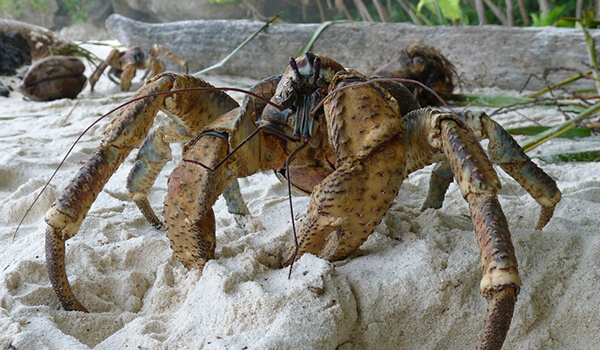
Photo: Palm Thief Cancer
You can rarely see them during the day, because they go out in search of food at night. In the light of the sun, they prefer to stay in the shelter. This may be a hole dug by the animal itself, or a natural shelter. Their dwellings are lined from the inside with coconut fiber and other plant materials that allow them to maintain the high humidity they need for a comfortable life. The crayfish always covers the entrance to its dwelling with a claw, this is also necessary so that it remains wet.
Despite such a love for moisture, they do not live in water, although they try to settle nearby. They can often come to its very edge and get a little wet. Young crayfish settle in shells left by other mollusks, but then they grow out of them and are no longer used.
It is not uncommon for palm thieves to climb trees. They do this quite deftly, with the help of the second and third pairs of limbs, but sometimes they can fall – however, this is nothing to worry about for them, they survive a fall from a height of up to 5 meters without any problems. If they move backwards on the ground, then they descend from the trees head first.
They spend most of the night either on the ground, eating the prey found, less often hunting, or near the water, and in the late evening and early morning they can be found on trees – for some reason they love to climb there. They live quite a long time: they can grow up to 40 years, and then they don’t die at all right away – there are individuals who have reached 60 years old.
Social structure and reproduction
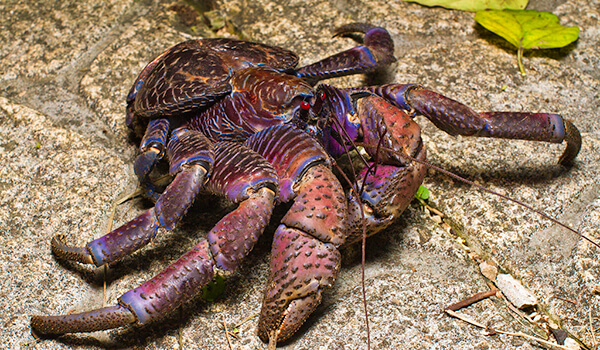
Photo: Palm Thief Crab
Palm thieves live alone and are found only during the breeding season: it begins in June and lasts until the end of August. After a long courtship, the crayfish mate. A few months later, the female waits for good weather and goes to the sea. In shallow water, she enters the water and releases eggs. Sometimes the water picks them up and carries them away, other times the female waits in the water for hours until the larvae hatch from the eggs. At the same time, she does not go far, because if the wave takes her away, then she will simply die in the sea.
Laying is done at high tide so that the eggs do not wash back to the shore, where the larvae will die. If everything went well, many larvae are born, which are not yet similar to an adult palm thief. For the next 3-4 weeks, they float on the surface of the water, noticeably grow and change. After that, small crustaceans sink to the bottom of the reservoir and crawl along it for some time, trying to find a home for themselves. The faster this can be done, the more chances to survive, because they are still completely defenseless, especially their abdomen.
An empty shell or a shell from a small nut can become a house. At this time, they are very similar to hermit crabs in appearance and behavior, constantly remain in the water. But the lungs gradually develop, so that over time, young crayfish come to land – someone earlier, someone later. Initially, a shell is also found there, but at the same time, their abdomen becomes harder and harder, so that over time the need for it disappears, and they discard it.
As they grow, they regularly molt – they form a new exoskeleton, and they eat the old one. So over time, they turn into adult crayfish, changing dramatically. Growth is slow: they reach sexual maturity only by the age of 5, and even by this age they are still small – about 10 cm.
Natural enemies of palm thieves
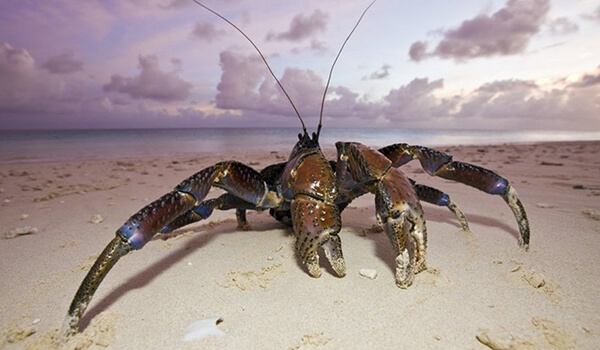
Photo: Palm Thief
There are no specialized predators for which palm thieves are the main prey. They are too big, well protected and even dangerous to be constantly hunted. But this does not mean that nothing threatens them: large cats and, more often, birds can catch and eat them.
But only a large bird is capable of killing such a cancer, not every tropical island has such ones. Basically, they threaten young individuals that have not even grown to half the maximum size – no more than 15 cm. Birds of prey such as kestrel, kite, eagle, and so on can catch them.
There are much more threats to larvae : they can become food for almost any aquatic animals that feed on plankton. Mostly fish and marine mammals. They eat most of the larvae, and only a few of them survive to land.
We must not forget about the man: despite the fact that palm thieves try to settle on islands as quiet and uninhabited as possible, they often turn out to be victims of people. All because of their tasty meat, and their large size does not play in their favor: they are easier to spot, and it is easier to catch one such crayfish than a dozen small ones.
An interesting fact: this crayfish was known as a palm thief because he likes to sit on palm trees and steal everything that glitters. If it comes across tableware, jewelry, and indeed any metal, the cancer will definitely try to take it into its home.
Population and view status
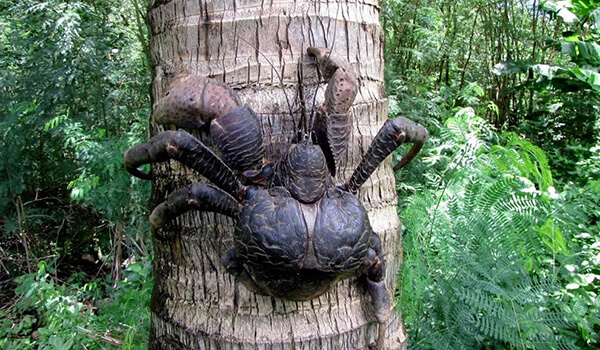
Photo: What the palm thief looks like
How many representatives of this species are found in nature has not been established due to the fact that they inhabit poorly inhabited places. Therefore, they are not included in the list of rare species, however, in those territories where records are kept, there has been an alarming decline in their numbers over the past half century.
The main reason for this is the active capture of these crayfish. Not only is their meat delicious, and therefore expensive – palm thieves taste like lobsters; in addition, it is also considered an aphrodisiac, which makes the demand even higher. Therefore, in many countries, restrictions are placed on their production or bans on catching are introduced at all. So, if earlier dishes from this crayfish were very popular in New Guinea, more recently it has been generally forbidden to serve it in restaurants and eateries. As a result, one of the important sales markets for smugglers has been lost, although exports continue in large volumes, so there is still work to be done to prevent it.
In some countries and territories there are bans on catching small crayfish: for example, in the Northern Mariana Islands it is allowed to catch only those that are larger than 76 mm, and only under license and from September to November. For this entire season, under one license, you can get no more than 15 crayfish. In Guam and Micronesia, the capture of pregnant females is prohibited, in Tuvalu there are territories where production is allowed (with restrictions), and there are forbidden ones. Similar restrictions apply in many other places.
All these measures are designed to prevent palm thieves from disappearing. It is still too early to judge their effectiveness, since in most countries they have been operating for no more than 10-20 years; but the basis for comparison and selection of the optimal strategy for the future due to the variety of legislative measures in different territories is very extensive. These large crayfish need protection, otherwise people can simply exterminate them. Of course, certain measures are being taken, but it is not yet clear whether they are sufficient to preserve the species. On some islands, where the palm thief used to be widespread, they are almost never found – this trend cannot but frighten.

